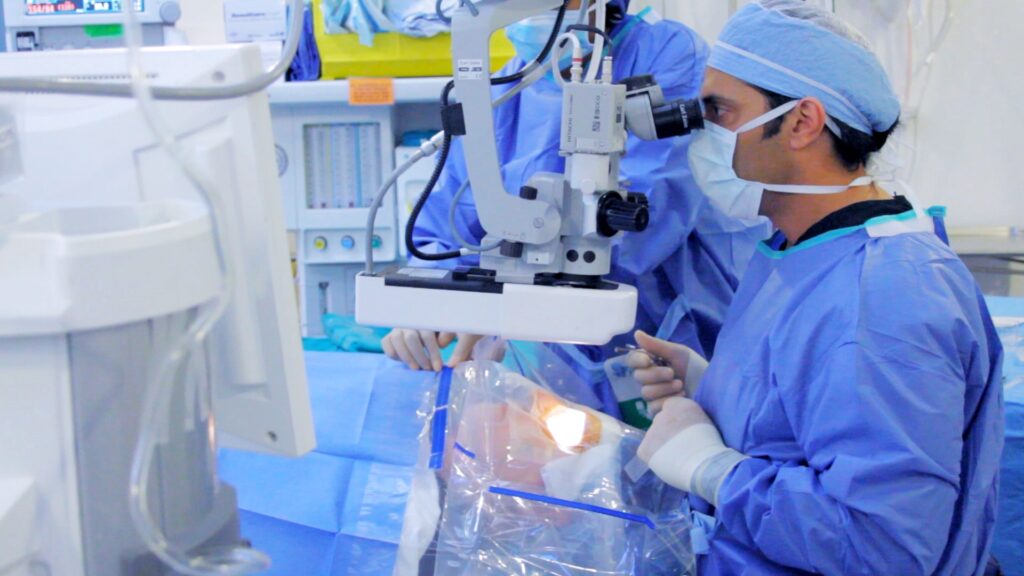Cataract eye surgery is a common procedure that many Sydney patients undergo to improve their vision and quality of life. If you have been diagnosed with cataracts or are considering cataract eye surgery, it is important to understand the procedure, the pre-surgery process, the surgery itself, and the post-surgery care and recovery. Additionally, choosing the right surgeon in Sydney is crucial for a successful outcome. In this complete guide, we will walk you through everything you need to know about cataract eye surgery.
Understanding Cataract Eye Surgery
Before diving into the details, let’s begin by understanding what cataract eye surgery is and why it is necessary. Cataract eye surgery is a procedure that involves removing the cloudy lens of the eye, known as a cataract, and replacing it with an artificial lens called an intraocular lens (IOL). As we age, the proteins in our lenses can clump together, causing them to become cloudy and impairing our vision. This condition, known as cataracts, is a common age-related vision problem, and cataract eye surgery is the most effective treatment for it.
What is Cataract Eye Surgery?
Cataract eye surgery, also known as cataract extraction, is a precise surgical procedure that aims to restore clear vision by removing the cloudy lens and replacing it with an artificial lens. This surgery is typically performed on an outpatient basis and is considered safe and effective for most patients with cataracts.

The Anatomy of the Eye and Cataracts
Before delving further into cataract eye surgery, let’s take a moment to understand the anatomy of the eye and how cataracts develop. The eye is a complex organ that consists of several structures, including the cornea, iris, lens, and retina. The cornea is the clear, dome-shaped front surface of the eye that helps to focus incoming light. The iris, which is the colored part of the eye, controls the amount of light that enters the eye by adjusting the size of the pupil. The lens, located behind the iris, plays a crucial role in focusing light onto the retina, which then sends visual signals to the brain.
Over time, the proteins in the lens can start to clump together, forming a cataract. This cloudiness in the lens obstructs the passage of light and leads to blurred or impaired vision. Cataracts can develop in one or both eyes and can vary in severity. Some people may experience mild cataracts that only slightly affect their vision, while others may have more advanced cataracts that significantly impair their ability to see clearly.
It’s important to note that cataracts are not caused by overusing the eyes or from activities such as reading in dim light or watching too much television. They are a natural part of the aging process and can also be influenced by factors such as genetics, diabetes, smoking, and prolonged exposure to ultraviolet (UV) radiation from the sun. Read more about genetics on https://genetics.hms.harvard.edu/
The Pre-Surgery Process
Once you have been diagnosed with cataracts and have decided to undergo cataract eye surgery, there are several steps you will need to take before the actual procedure.
Understanding the pre-surgery process is crucial for patients considering cataract eye surgery. This period involves a series of consultations, evaluations, and preparations to ensure the best possible outcome for the patient.
Initial Consultation and Diagnosis
The first step in the pre-surgery process is scheduling an initial consultation with a skilled ophthalmologist. During this appointment, the ophthalmologist will thoroughly examine your eyes and confirm the presence of cataracts. They will also assess your overall eye health and discuss your medical history to ensure you are a suitable candidate for surgery.
Furthermore, the initial consultation is an opportunity for patients to ask questions, express any concerns they may have, and gain a better understanding of what to expect during and after the cataract surgery. Building a rapport with your ophthalmologist at this stage can help alleviate any anxiety and build trust in the surgical process.
Preparing for Cataract Eye Surgery
After the diagnosis, your surgeon will provide you with detailed instructions on how to prepare for the surgery. This may include refraining from eating or drinking for a certain period before the surgery, adjusting any medications you are currently taking, and arranging for transportation to and from the surgical center on the day of the procedure. It is essential to follow these instructions carefully to ensure a smooth and successful surgery.
Patients are encouraged to inform their surgical team about any allergies, existing medical conditions, or medications they are taking to prevent any complications during the surgery. Additionally, discussing post-operative care and recovery expectations can help patients plan ahead for a comfortable and effective healing process. To read more about allergies click here.
The Cataract Surgery Procedure
Now that you have completed the pre-surgery process, let’s take a closer look at what actually happens during the cataract eye surgery procedure. Cataracts are a common condition that occur when the natural lens of the eye becomes cloudy, leading to blurry vision and difficulty seeing clearly. Cataract surgery is a safe and effective procedure that can help restore clear vision and improve quality of life for many individuals.
Step-by-Step Breakdown of the Surgery
Cataract eye surgery is typically performed using a technique called phacoemulsification. This procedure involves making a small incision in the cornea, through which the surgeon inserts a tiny ultrasound probe. The probe emits ultrasonic waves that break up the cloudy lens into tiny fragments. These fragments are then gently suctioned out of the eye. Once the lens is removed, an artificial intraocular lens is implanted to replace it. This new lens helps to restore clear vision and improve the overall visual quality. The entire surgery usually takes about 15-20 minutes per eye and is performed on an outpatient basis, meaning you can go home the same day.
Risks and Complications
Like any surgical procedure, cataract eye surgery carries some risks and potential complications. However, the complications associated with this surgery are relatively rare and typically minor. Some possible risks include infection, bleeding, increased intraocular pressure, and retinal detachment. It is important to discuss these risks with your surgeon prior to the surgery to ensure you are fully informed and prepared. Your surgeon will provide detailed post-operative instructions to help minimize the risk of complications and promote proper healing. It is essential to follow these instructions carefully and attend all follow-up appointments to monitor your recovery progress.
Post-Surgery Care and Recovery
After the surgery, your eye will need time to heal, and following proper post-surgery care instructions is crucial for a successful recovery. It’s important to remember that each individual’s healing process may vary, so patience and adherence to the guidelines provided by your healthcare provider are key.
Understanding what to expect after cataract eye surgery can help you navigate the recovery period more effectively. In addition to mild discomfort and blurry vision, some patients may also experience sensitivity to light or fluctuations in vision clarity. These symptoms are typically temporary and should improve as your eye continues to heal.
What to Expect After Surgery
Following cataract eye surgery, it is normal to experience some mild discomfort and blurry vision. Your surgeon will likely prescribe eye drops to help reduce inflammation and prevent infection. It is important to use the prescribed eye drops as directed and attend follow-up appointments to monitor your healing progress.
During the recovery period, it’s common to have questions or concerns about your progress. Don’t hesitate to reach out to your healthcare provider if you experience persistent pain, sudden changes in vision, or any other worrisome symptoms. Open communication with your medical team can help address any issues promptly and ensure a smoother recovery process.
Tips for a Smooth Recovery
To aid in your recovery, it is essential to follow your surgeon’s post-surgery care instructions. These instructions may include avoiding activities that put excess strain on your eyes, wearing protective eyewear, and avoiding contact with water or irritants. Additionally, maintaining good overall health, eating a nutritious diet, and getting adequate rest can help expedite your recovery.
Engaging in gentle eye exercises as recommended by your healthcare provider can also promote healing and improve your visual outcomes. These exercises are designed to strengthen the muscles around your eyes and enhance your visual acuity over time. Remember to approach these exercises with caution and discontinue any activity that causes discomfort or pain.

Choosing the Right Surgeon in Sydney
When it comes to cataract eye surgery, choosing the right surgeon in Sydney is paramount for a successful outcome. Your eyes are precious, and entrusting them to a skilled and experienced professional is crucial for a smooth and effective procedure.
It’s not just about finding any surgeon; it’s about finding the best surgeon for your specific needs. Take the time to research and evaluate different surgeons to ensure you make an informed decision that you feel confident about.
Factors to Consider When Choosing a Surgeon
When selecting a surgeon, it is essential to consider their experience, credentials, and patient reviews. Look for a surgeon who specializes in cataract surgery and has a good track record of successful procedures. Additionally, you may want to consider their communication style, the accessibility of their clinic, and their commitment to patient satisfaction. A surgeon who is not only skilled but also empathetic and communicative can make a significant difference in your surgical experience.
Furthermore, don’t hesitate to schedule consultations with potential surgeons to get a feel for their approach and expertise. This face-to-face interaction can help you gauge their professionalism and how comfortable you feel entrusting them with your eye health.
Understanding Surgeon Qualifications and Experience
Before making a decision, it is important to understand the qualifications and experience of the surgeon. Verify if the surgeon is board-certified and has undergone specialized training in cataract surgery. Additionally, inquire about their experience level and the number of cataract surgeries they have performed. Feel free to ask for patient testimonials and before-and-after photos as well. Seeing tangible evidence of their past work can give you insight into what you can expect in terms of results.
Remember, this is your vision at stake, so don’t rush the decision-making process. Take the time to research, ask questions, and trust your instincts when choosing the right cataract surgeon in Sydney.
Conclusion
In conclusion, cataract eye surgery is a safe and effective procedure that can significantly improve your vision and quality of life. By understanding the surgery process, preparing adequately, following post-surgery care instructions, and choosing the right surgeon, you can ensure a successful outcome and a smooth recovery. If you are a Sydney patient considering cataract eye surgery, consult with an experienced ophthalmologist to assess your options and embark on your journey to clearer vision.
Read about retinal treatments at: Laser Retinal Treatments

